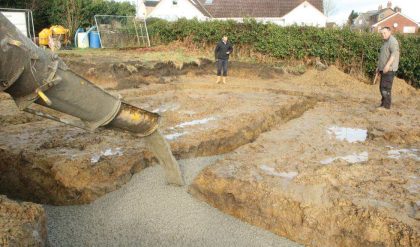Principal building stones generally used in the United States are limestones, marbles, granites, and sandstones. Other stones such as serpentine and quartzite are used locally but to a much lesser extent. Stone, in general, makes an excellent building material, if properly selected on the basis of experience; but the cost may be relatively high.
Properties of stone depend on what nature has provided. Therefore, the designer does not have the choice of properties and colour available in some of the manufactured building units. The most the stone producer can do for purchasers is to avoid quarrying certain stone beds that have been proved by experience to have poor strength or poor durability.
Properties Of Building Stones
Data on the strength of building stones are presented in Table 4.10, summarized from U.S. National Bureau of Standards Technical Papers, No. 123, B. S. Vol. 12;
TABLE 4.10 Strength Characteristics of Commercial Building Stones

No. 305, Vol. 20, p. 191; No. 349, Vol. 21, p. 497; Journal of Research of the National Bureau of Standards, Vol. 11, p. 635; Vol. 25, p. 161). The data in Table 4.9 pertain to dried specimens. Strengths of saturated specimens may be either greater or less than that of completely dry specimens.
The modulus of rupture of dry slate is given in Table 4.10 as ranging from 6000 to 15,000 psi. Similar slates, tested wet, gave moduli ranging from 4700 to 12,300 psi. The ratio of wet modulus to dry modulus varied from 0.42 to 1.12 and averaged 0.73.
Data on the true specific gravity, bulk specific gravity, unit weights, porosity, and absorption of various stones are given in Table 4.11.
Permeability of stones varies with types of stone, thickness, and driving pressure that forces water through the stone. Table 4.12 represents data for the more common stones at three different pressures, as reported in ‘‘Permeability of Stone,’’ U.S. National Bureau of Standards Technical Papers, No. 305, Vol. 20, p. 191. The units of measurement of permeability are cubic inches of water that will flow through a square foot of a specimen 1 ⁄2 in thick in 1 hr.
Data on thermal expansion of building stones as given in Table 4.13 show that limestones have a wide range of expansion as compared with granites and slates.
Marble loses strength after repeated heating and cooling. A marble that had an original strength of 9174 psi had a strength after 50 heating’s to 150C of 8998 psi—a loss of 1.9%. After 100 heating’s to 150C, the strength was only 8507 psi, or a loss of 7.3%. The latter loss in strength was identical with that obtained on
TABLE 4.11 Specific Gravity and Porosity of Commercial Building Stones

TABLE 4.12 Permeability of Commercial Building Stones

TABLE 4.13 Coefficient of Thermal Expansion of Commercial Building Stones

freezing and thawing the same marble for 30 cycles. Also, marble retains a permanent expansion after repeated heating.

